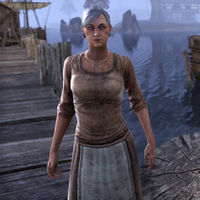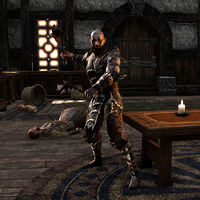Lore:Murcien's Hamlet
| Murcien's Hamlet | |
|---|---|
| Type | Settlement |
| Continent | Tamriel |
| Province | High Rock |
| Region | Western Reach, Bangkorai (Mournoth) |
| Appears in | ESO |

Murcien's Hamlet was a settlement located in Mournoth, in northern Bangkorai, situated on the frontier between High Rock and the Reach.[1] It was a humble settlement, with the majority of its residents engaged in the fishing industry. The hamlet included weavers and boat-builders who crafted small fishing smacks and coracles for river trade. They actively participated in river commerce.[2][3] Its population had strong ties to both the Reachfolk and the Bretons. Throughout its history, Murcien's Hamlet exchanged hands between the Reachfolk and the Bretons,[4] because of its location in the Western Reach. It was positioned to the north of Evermore and situated along the shoreline of Halcyon Lake, north of the Bjoulsae River.[1][5]
History[edit]
The precise origins of Murcien's Hamlet remains unclear. The settlement was established on land originally inhabited by the Reachfolk before it came under Breton control. Despite falling within Breton jurisdiction, some families in Murcien's Hamlet had Reachfolk origins or ancestry.[4][6][7] Additionally, certain residents continued to embrace Reachfolk culture and traditions.[4][8] A poem discovered in one of the village's old homes speaks about a noblewoman named Lady Murcien, who had a peculiar belief that she was a Dwarf. While her connection to the settlement's history remains uncertain, both she and the town share the name.[9][10]
At some point the settlement was a target of a Reachfolk raid, notably by the Crow-Wife Clan. Among the captives, Arthenice Belloq managed to escape her captivity and later published her experiences with the Reachfolk.[3]
In the year 2E 541, Murcien's Hamlet witnessed no recorded births. On the 10th of Second Seed, Stella Gedanis and Robert Jurelette joined in matrimony, establishing their residence along the water's edge in the Jurelette home. Tragedy struck on the 4th of Mid Year, claiming the life of 35-year-old Patrand Zurric, who drowned in the Bjoulsae River while intoxicated, leaving behind his grieving wife, Medya Zurric.[11] The village became a target during the Durcorach's invasion,[12] which took place during his conquest of High Rock in the years 2E 541 to 2E 542.[13][14] The Reachfolk outwitted the Breton cavalry by utilizing the natural terrain, such as trees, rocks, as well as buildings within the village. These tactics enabled them to outmaneuver Breton mounted forces. While the Reachmen's invasion was ultimately repelled, the Battle of Murcien Hamlet was a victory for the Reach.[12] As a result of the invasion the entire Chamrond family perished during a Reach invasion, resulting in the town's devastation and the loss of historical records.[11] Many inhabitants died during the invasion, but some, including Medya managed to survive. Since that time, the village has not faced further raids.[2] In the subsequent year, 2E 542, joy and sorrow intertwined. On the 25th of Sun's Dawn, Roberta was born to Stella and Robert Jurelette. However, this happiness was tinged with grief as Stella succumbed to childbed fever on the 28th of Sun's Dawn without laying eyes on her newborn. She was survived by her husband, Robert, and their daughter. On the 28th of Rain's Hand, Jester's Day, Labhraidh, the child of Medya Zurric, widow of Patrand Zurric and a survivor of the Black Drake's invasion was born.[11]
In 2E 582, the lone surviving resident who witnessed the invasion was Medya, now an elder of the village. At that time, Medya Zurric was considered the informal leader of the community. Since the invasion, everyone who recalled those events, except Medya, has either perished or departed from the settlement.[2] Medya believed in the potential of the hamlet, describing it as a once-beautiful community with deep roots. However, she acknowledged its current state of being wild and corrupted. Her goal was to restore the settlement under Reach jurisdiction.[4] Many of the current inhabitants belonged to ancestral families descended from the Reachfolk, the indigenous people of the region. These families had been warned about the impending invasion and were assured that they would be spared during the attack. While some were elated by this news, others were dismayed and began making arrangements to relocate to Evermore.[6][7][15] Soon the village faced an attack from the Dark Witnesses, a faction of Reachfolk. This particular branch of this group was led by Labhraidh, the son of Medya and a native of the hamlet. Interestingly, very few townsfolk were aware of the fact that Medya had a son. Collaborating with his mother, Labhraidh orchestrated the invasion. The Bretons were caught off guard by the attack, as the Reachfolk employed similar strategies as they did 30 years ago, taking the Bretons by surprise. However, with the assistance of a traveling adventurer, the Bretons managed to repel the invasion and defeat Labhraidh.[15][4][12] The Breton city guard of Evermore, under the initial leadership of Sir Etienne Hu, was dispatched to defend the hamlet from the invasion.[12] Members of the Evermore city guard stayed watchful on the road, on the lookout for possible reinforcements that the Reachmen could receive, waiting until their own forces arrived.[16][17] After the invasion, Medya Zurric was captured. It is unclear whether she was brought to Evermore for trial or executed on the spot.[15] This sparked varied opinions and reactions both among the villagers,[2][5][18] and members of the guard. Opinions among the guard were divided; some members were indifferent,[19] while others favored a trial.[20][21] There were also those who expressed satisfaction at her immediate execution.[22][23][24] While peace was restored to the hamlet, its future remained uncertain.[15]
Notes[edit]
- Military officers stationed in Murcien's Hamlet were known to utilize spyglasses to observe activity across the river in Evermore.[25] Sir Etienne of Murcien's Hamlet rewarded officers who displayed bravery in the field with Murcien's Badges of Courage.[26]
See Also[edit]
- For game-specific information, see the Elder Scrolls Online article.
Books[edit]
- The Reachmen are Coming!
- We Will Be Spared
- Vital Records, 2E 541—2E 542 — A record of births and deaths
- Lady Murcien's Folly by Anonymous — Poem about a lady who thought she was a Dwarf
Reference[edit]
- ^ a b Murcien's Hamlet in ESO
- ^ a b c d Rolbert Foucher's dialogue in ESO
- ^ a b A Life Barbaric and Brutal — Arthenice Belloq
- ^ a b c d e Medya Zurric's dialogue in ESO
- ^ a b Chantisse Ascent's dialogue in ESO
- ^ a b The Reachmen are Coming!
- ^ a b We Will Be Spared
- ^ Labhraidh's dialogue in ESO
- ^ Lady Murcien's Folly — Anonymous
- ^ Lady Murcien's Folly's location in Murcien's Hamlet in ESO
- ^ a b c Vital Records, 2E 541—2E 542
- ^ a b c d Squire Theo Rocque's dialogue in ESO
- ^ Travails and Triumphs of a Monarch — His Majesty King Emeric
- ^ The Royal House of King Eamond — Seneschal Derric Andras of Castle Evermore
- ^ a b c d Events of The Charge of Evermore in ESO
- ^ Sergeant Eubella Bruhl's dialogue in ESO
- ^ Kahaba's dialogue in ESO
- ^ Marjaques Dauzat's dialogue in ESO
- ^ Muzgraga gra-Khambol's dialogue in ESO
- ^ Ahobi's dialogue in ESO
- ^ Colwyn Frinck's dialogue in ESO
- ^ Rozette Emard's dialogue in ESO
- ^ Glolbikla's dialogue in ESO
- ^ Horayya's dialogue in ESO
- ^ Murcien's Badge of Courage item description in ESO
- ^ Murcien's Spyglass item description in ESO

